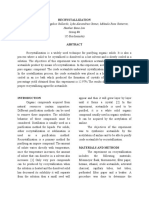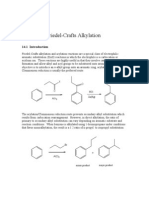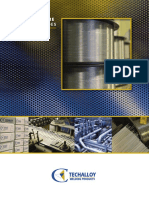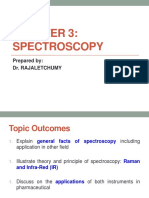Lelm 110 Okio
Lelm 110 Okio
Uploaded by
AMAN10344Copyright:
Available Formats
Lelm 110 Okio
Lelm 110 Okio
Uploaded by
AMAN10344Original Description:
Original Title
Copyright
Available Formats
Share this document
Did you find this document useful?
Is this content inappropriate?
Copyright:
Available Formats
Lelm 110 Okio
Lelm 110 Okio
Uploaded by
AMAN10344Copyright:
Available Formats
UNIT-10
PREPARATION OF ORGANIC COMPOUNDS
Material Required
no t
to N be C E re R pu T bl is he d
EXPERIMENT 10.1
Aim
To prepare acetanilide.
Theory
The replacement of one hydrogen atom of the NH2 group of aniline by CH3CO group in the presence of glacial acetic acid. Gives acetanilide. In the laboratory, acetylation is usually carried out with acetic anhydride. Acetyl chloride may also be used for the purpose of acetylation if acetic anhydride is not available. Acetylation with CH3COCl is usually carried out in the presence of pyridine.
Funnel Round bottomed flask (100 mL) Beaker (250 mL) Air condenser Sand bath Clamp and iron stand Pumice stone Melting point assembly
: : : : : : : :
One One One One One One As per need One
Aniline : 5 mL Acetic anhydride /Acetyl chloride : 5 mL Acetic acid / Pyridine : 5 mL
Procedure
(i) Take 5 mL of aniline in a 100 mL round bottom flask and add acetylating mixture containing 5 mL acetic anhydride and 5 mL glacial acetic acid. Alternatively, you can use 5 mL of acetyl chloride and 5 mL of dry pyridine as the acctylating mixture.
PREPARATION OF ORGANIC COMPOUNDS
(ii)
(iii) (iv)
(v)
Fit an air condenser on the mouth of the round bottom flask after adding a few pumice stones and reflux the mixture gently for 10-15 minutes on a sand bath. Cool the reaction mixture and pour it slowly in 150-200 mL of ice cold water with stirring. Filter the solid, wash it with cold water and recrystallise a small amount of sample from hot water containing a few drops of methanol or ethanol. Report the yield and the melting point of the compound.
Aniline Acetic anhydride Acetyl chloride Acetic acid causes serious burn
Result
(a) (b)
Yield of acetanilide _______ g. Melting point of acetanilide is _______ C.
Precautions
(a)
Handle acetic anhydride and acetyl chloride carefully as they cause irritation to the eyes and acetyl chloride also strongly fumes in air. (b) Store acetylchloride under dry conditions. (c) Handle pyridine with extreme caution. Dispense it in an efficient fume cupboard and wear disposable glasses while using it. (d) Distil pyridine before use because it absorbs mioisture and the reaction does not take place under moist conditions. (e) Wash the solid 2-3 times with cold water till the filtrate is neutral to litmus. (f) Determine the melting point of perfectly dried and recrystallised sample.
A LTERNATIVE METHOD FOR THE PREPARATION OF ACETANILIDE
If acetic anhydride or pyridine is not available then the following method can be used for the preparation of acetanilide.
Material Required
no t
Boiling tube Water bath Melting point assembly Funnel
to N be C E re R pu T bl is he d
Pyridine
: : : :
One One One One
Aniline : 1 mL Glacial acetic acid : 1 mL Acetyl chloride : 1 mL
105
LABORATORY MANUAL CHEMISTRY
Procedure
(i) (ii) Take 1 mL of aniline in a dry boiling tube, add 1 mL of glacial acetic acid to it and mix the two thoroughly. To the above mixture add 1 mL of acetyl chloride in lots (0.3 mL at a time). The mixture becomes warm. If the boiling tube becomes unbearable to touch, cool it under tap water. After addition of whole amount of acetyl chloride, heat the mixture for five minutes in a boiling water bath. Cool the boiling tube and add ice-cold water (~10 mL) into the tube with constant stirring. Filter the acetanilide separated as white powder and wash with water till filtrate is neutral to litmus. Crystallise the crude acetanilide with hot water. White shining needle shaped crystals are obtained. Report the yield and melting point of the compound.
(iii) (iv)
Precautions
(a)
(b) (c) (d)
no t
106
to N be C E re R pu T bl is he d
(v) (vi) (vii) If aniline sample is too much coloured, distill it before carrying out the experiment, because yield is lowered with impure aniline. Use perfectly dry apparatus. Do not inhale the vapours coming out during the addition of acetylchloride. Determine the melting point of perfectly dried and recrystallized sample.
EXPERIMENT 10.2
Aim
To prepare dibenzalacetone (Dibenzylideneacetone)
Theory
-Hydrogen atom of aliphatic aldehydes and ketones is acidic in nature, therefore, in the presence of dilute alkali, such an aldehyde or ketone condenses with an aromatic aldehyde to give , unsaturated aldehyde or ketone. This reaction is called Claisen Schmidt reaction. For example, benzaldehyde undergoes condensation with acetone in the presence of aqueous sodium hydroxide (NaOH) to give dibenzalacetone.
PREPARATION OF ORGANIC COMPOUNDS
Material Required
Ethanol NaOH Benzaldehyde Acetone Ice Ethylacetate : : : : : : 25 mL 3.15 g 3.2 mL 2.3 mL As per need As per need
Conical flask(250 mL) : Beaker(250 mL) : Funnel : Melting point assembly :
One One One One
Procedure
(i)
(ii)
(iii) (iv)
(v)
Prepare a solution of 3.15 g sodium hydroxide in a mixture of 25 mL ethanol and 30 mL distilled water taken in a 250 mL beaker. Cool the beaker in an ice bath maintained at a temperature of about 2025C. Prepare a mixture of 3.2 mL of benzaldehyde and 2.3 mL of acetone and add half of this mixture slowly in ice cooled NaOH solution prepared in step (i) with vigourous stirring. A fluffy precipitate is formed within 1-2 minutes. Stir the mixture gently for about fifteen minutes. After 15 minutes add remaining mixture of benzaldehyde and acetone and stir for 30 minutes more. Filter the pale yellow solid so obtained and wash with cold water. Dry it and recrystallise its small amount from ethanol or ethyl acetate. Report the yield and the melting point of the compound.
Result
(a) (b)
Yield of dibenzalacetone is _________g. Melting point of dibenzalacetone _______C.
Precautions
EXPERIMENT 10.3
Aim
To prepare p-nitroacetanilide.
no t
(a) Maintain the temperature around 20C while shaking the reaction mixture. (b) Always use freshly distilled benzaldehyde or the sample from a freshly opened bottle.
to N be C E re R pu T bl is he d
Ethanol NaOH Benzaldehyde Acetone Ethyl acetate
107
LABORATORY MANUAL CHEMISTRY
Theory
p-Nitroacetanilide is prepared by the nitration of acetanilide by using a mixture of conc. nitric acid and conc. sulphuric acid as nitrating reagent. The mixture of the two acids releases nitronium ion( NO+ ), which acts as an electrophile in the reaction. 2 + H 3O + + 2H SO HNO3 + 2H2SO4 NO+ 2 4
Material Required
Acetic acid causes severe burns
Hazard Warning
no t
Acetanilide may cause cyanosis.
108
to N be C E re R pu T bl is he d
Beaker (100 mL) Funnel Glass rod Ice bath : : : : One One One One Acetanilide Glacial acetic acid Conc. H2SO4 Conc. HNO3 Ice Ethanol/methanol : : : : : : 2g 2 mL 5 mL 1.5 mL As per requirement As per requirement
Nitronium ion attacks the benzene ring containing anilide group, mainly at the para position to give p -nitroacetanilide as a major product. This is an example of aromatic electrophilic substitution reaction.
Procedure
(i) Dissolve 2 g of acetanilide in 2 mL of glacial acetic acid taken in a 100 mL beaker. (ii) Add 4 mL of conc. H2SO4 gradually with stirring to the above mixture. The mixture becomes hot and clear solution is obtained. Cool the reaction mixture in an ice bath maintained at 0-5 C. (iii) Add a cold mixture of 1.0 mL conc. HNO3 and 1.0 mL conc. H2SO 4 to the viscous reaction mixture drop by drop with constant stirring, so that the temperature of the mixture does not rise above 10C. (iv) Remove the beaker from the ice bath and allow the reaction mixture to attain room temperature. Let it stand at room temperature for about 30 minutes. Stir the reaction mixture continuously and pour it on 100g of crushed ice. (v) Stir the mixture well and filter the compound so obtained.
PREPARATION OF ORGANIC COMPOUNDS
(vi) Wash the compound with cold water and dry it. (vii) Recrystallise a small amount of the pale yellow solid from alcohol. Colourless crystals of p-nitroacetanilide are obtained. Yellow ortho-nitroacetanilide formed in the small amount remains dissolved in the mother liquor. (viii) Record the yield and melting point of the pure compound.
Result
Precautions
(a)
Do not allow the temperature of the reaction mixture to exceed 10C during addition of nitrating mixture. (b) Add mixture of concentrated nitric acid and sulphuric acid into the solution of acetanilide slowly and carefully.
EXPERIMENT 10.4
Aim
To prepare phenylazo-naphthol (an azo dye).
Theory
Aniline is an aromatic primary amine. It forms diazonium salt when treated with nitrous acid at 0-5C. Nitrous acid is generated in situ by the reaction of sodium nitrite with hydrochloric acid. The process is called diazotisation. The diazonium salt is coupled with an alkaline solution of -naphthol to form an orange-red azo dye.
no t
to N be C E re R pu T bl is he d
109
(a) (b)
Yield of p-nitroacetanilide is _______ g. Melting point of p -nitroacetanilide is ______C.
LABORATORY MANUAL CHEMISTRY
Material required
Aniline Conc. HCl Sodium nitrite -naphthol Sodium hydroxide Glacial acetic acid Ice Distilled water : : : : : : : : 2 mL 6.5 mL 1.6 g 3.2 g 2.0 g 12.0 mL As per need As per need
Aniline
HCl
Sodium nitrite
Sodium hydroxide
-naphthol
Acetic acid causes severe burns
no t
110
to N be C E re R pu T bl is he d
Procedure
(i)
Beaker (250mL) : Conical flask (100mL) : Glass rod : Thermometer (210 C) : Filter paper : Funnel : Melting point assembly :
One One One One As per need One One
Take 6.5 mL of concentrated hydrochloric acid in a 100 mL beaker. Dilute it with 6.5 mL of water and dissolve 2 mL of aniline in it. (ii) Cool the above mixture by placing the beaker in an ice bath maintained at 0-5 C temperature. (iii) Diazotise the above mixture by adding a solution of 1.6 g of sodium nitrite in 8 mL water. (iv) Dissolve 3.2 g -naphthol in 18 mL of 10% sodium hydroxide solution. Add about 25 g of crushed ice to it. (v) Stir the -naphthol solution well and add chilled diazonium chloride solution very slowly to it with constant stirring. (vi) An orange red dye of phenyl-azo--naphthol is formed. (vii) Allow the mixture to stand in the bath for 30 minutes with occasional shaking. (viii) Filter the crystals obtained and wash them well with cold water. (ix) Recrystallise about one-fourth of the crude product from glacial acetic acid. (x) Filter the recrystallised sample, wash with a little alcohol to remove acetic acid. Dry the recrystallised sample between the folds of a filter paper. (xi) Record the yield and the melting point of the compound.
Result
(a) (b) Yield of phenylazonaphthol is ______g and its Melting point of phenyl-azo--naphthol is _______ C.
PREPARATION OF ORGANIC COMPOUNDS
Precautions
(a) (b) (c ) Maintain the temperature in the range of 0-5C during diazotisation. Always add diazonium chloride solution in alkaline -naphthol for dye formation and not vice versa. Dry the recrystallised sample perfectly for determining the melting point.
EXPERIMENT 10.5
Aim
To prepare aniline yellow (p-amino-azobenzene).
Theory
p -aminoazobenzene can be prepared in a good yield by rearrangement reaction of diazoaminobenzene with a small quantity of aniline hydrochloride in the presence of aniline as solvent. The chemistry of this conversion is as follows:
The above reaction is carried out only in weekly acidic conditions.
no t
Material Required
Conical Flask (100 mL) Thermometer Funnel Melting point assembly Waterbath
to N be C E re R pu T bl is he d
: : : : : One One One One One Diazoaminobenzene Aniline Aniline hydrochloride Glacial acetic acid Carbon tetrachloride : : : : : 3g 7 mL 1.5 g 9 mL 9 mL
Note : Azo-dye synthesis are mostly so nearly quantitative that one should use amounts of reactants closely agreeing with equations. Any excess of certain reactants may cause decomposition of unused material and tar may appear.
111
LABORATORY MANUAL CHEMISTRY
Procedure
(i) Dissolve 3 g of finely powdered diazoaminobenzene in 7 mL of aniline in a 100 mL conical flask. (ii) Add 1.5 g of finely powdered aniline hydrochloride to the above mixture. (iii) Warm the mixture with occasional shaking on a water bath at about 40-45C , for a period of about one hour. (iv) Remove the flask from the water bath and allow the reaction mixture to stand at room temperature for about 30 minutes. (v) Add 9 mL of glacial acetic acid diluted with an equal volume of water and shake the reaction mixture thoroughly to convert excess aniline to its acetate, which is water-soluble. (vi) Allow the mixture to stand for 15 minutes with occasional stirring. (vii) Filter p -aminoazobenzene, wash with a little cold water and dry between the folds of a filter paper. (viii) Recrystallise a small portion of crude p-aminoazobenzene from carbon tetrachloride. (ix) Report the yield and melting point of p-aminoazobenzene.
Aniline
Acetic acid causes severe burns Carbon tetrachloride
Precautions
(a) (b) (c)
no t
112
to N be C E re R pu T bl is he d
Result
Maintain the temperature of the reaction mixture at about 40-50C. Wash the crude product with a small volume of water repeatedly. Note the melting point of the perfectly dry sample.
Yield of paminoazobenzene is ______ g and its melting point is ____C.
AN A LTERNATIVE PROCEDURE FOR PREPARING ANILINE YELLOW
Theory
Aniline yellow can also be prepared by direct diazotisation and coupling as followed for phenyl-azo--naphthol dye. However, coupling of the diazonium salt with aniline or any other aromatic amine is carried out in a weakly acidic medium.
PREPARATION OF ORGANIC COMPOUNDS
Material Required
Funnel : Conical flask (100 mL) : Thermometer : Melting point assembly : One One One One
Aniline 1.0 M HCl Carbon tetrachloride
: : :
6 mL 4 mL As per need
(i)
(ii) (iii) (iv) (v)
Prepare a solution of benzene diazonium chloride using 2 mL of aniline according to the method described for the preparation of phenyl-azonaphthol dye (see experiment 10.4). Prepare a solution of 4 mL aniline in 4 mL 1.0 M HCl. Add the cold solution of aniline hydrochloride slowly into the cold solution of benzene diazonium chloride. Filter the yellow compound and dry it between the folds of a filter paper. Recrystallise the small amount of crude sample from carbon tetrachloride and report the yield and melting point.
Discussion Questions
(i) Why is acetic anhydride preferred over acetyl chloride for acetylation reaction?
(ii) In the preparation of p-nitroacetanilide another minor product is formed. What is this compound and how can this be separated from p -nitroacetanilide? (iii) Is it necessary to recrystallise the compound obtained from the reaction? Explain why. (iv) How is an organic compound recrystallised? (vi) How is crude solid compound purified? (v) What is the role of acetic acid or pyridine in acetylation?
(vii) Which of the following compounds on diazotisation followed by coupling with naphthol will form an azo dye? (a) p -Toluidine (b) Benzylamine (c ) N-Methylaniline. (viii) Why are diazonium chlorides usually soluble in water? (ix) How is methyl orange prepared in the laboratory? (x) How can phenol and aniline be distinguished chemically? (xi) Why is aniline soluble in hydrochloric acid while it is insoluble in water? (xii) Why is aniline a weaker base than ammonia?
(xiii) In contrast to aromatic primary amines, aliphatic primary amines do not form stable diazonium salts. Why?
no t
to N be C E re R pu T bl is he d
Aniline Carbon tetrachloride HCl
Procedure
113
You might also like
- Aspirin ExperimentDocument7 pagesAspirin ExperimentTrương Thị Bích LiễuNo ratings yet
- NCTF 135 and NCTF 135 HaDocument3 pagesNCTF 135 and NCTF 135 Hajosli100% (2)
- Null PDFDocument2 pagesNull PDFTanya DilshadNo ratings yet
- Nitration of Methyl BenzoateDocument3 pagesNitration of Methyl BenzoateDaniel McDermottNo ratings yet
- Organic Chemistry Practical 301Document22 pagesOrganic Chemistry Practical 301geetesh waghela100% (1)
- Organic Chem Lab FDocument33 pagesOrganic Chem Lab FRanjith Kumar mNo ratings yet
- Obtaining Pure Acetanilide From Crude Acetanilide by Recrystallization ProcessDocument5 pagesObtaining Pure Acetanilide From Crude Acetanilide by Recrystallization ProcessCharlot NavarroNo ratings yet
- Santa Monica College Chem 22 Lab ManualDocument59 pagesSanta Monica College Chem 22 Lab ManualMide Ogundipe100% (1)
- Experiment 32Document14 pagesExperiment 32Morgan Elizabeth Lepley100% (6)
- Sythesization and Purification of Acetanilide by Acetylation and Re CrystallizationDocument4 pagesSythesization and Purification of Acetanilide by Acetylation and Re CrystallizationToni Sy EncinaresNo ratings yet
- Synthesis of Acetyl Salicylic AcidDocument5 pagesSynthesis of Acetyl Salicylic AcidSilvia AryaniNo ratings yet
- Experiment 8 The Preparation of AcetanlideDocument12 pagesExperiment 8 The Preparation of AcetanlideRadhwanNo ratings yet
- Recrystallization PDFDocument5 pagesRecrystallization PDFMikee GutierrezNo ratings yet
- Di Benz Al AcetoneDocument3 pagesDi Benz Al AcetoneKristine Mae De GuzmanNo ratings yet
- Experiment 123456 1 PDFDocument18 pagesExperiment 123456 1 PDFHardi Ahmed100% (1)
- Lab+Manual+2014 Cbe 2207Document63 pagesLab+Manual+2014 Cbe 2207Krishnan Mohan100% (1)
- Benzoin Exp7Document4 pagesBenzoin Exp7Liz Hackett0% (1)
- Experiment 12 Preparation of Adipic Acid From CyclohexeneDocument6 pagesExperiment 12 Preparation of Adipic Acid From Cyclohexenesaransh1994No ratings yet
- AcetanilideDocument7 pagesAcetanilideepsonme101No ratings yet
- Final FileDocument209 pagesFinal Filenavneetkaur77No ratings yet
- Organic ChemistryDocument8 pagesOrganic ChemistryAndré Brincat100% (1)
- Cresols and Xylenols (P-Cresol)Document44 pagesCresols and Xylenols (P-Cresol)Marcus100% (1)
- 2 BenzophenoneDocument3 pages2 BenzophenoneElizabeth LawsonNo ratings yet
- Ekstraksi Senyawa Organik Asam, Basa, NetralDocument6 pagesEkstraksi Senyawa Organik Asam, Basa, NetralDaniel LieNo ratings yet
- Re Crystallization of Acetanilide 1 ColDocument5 pagesRe Crystallization of Acetanilide 1 ColMediatrix SaraosNo ratings yet
- DistillationDocument16 pagesDistillationAnonymous FGzDAs0SoNo ratings yet
- Preparation of Benzoic AcidDocument7 pagesPreparation of Benzoic AcidRoberta Piras0% (1)
- Acid-Catalyzed Dehydration of Cyclohexanol To Cyclohexene Lab - ReportDocument7 pagesAcid-Catalyzed Dehydration of Cyclohexanol To Cyclohexene Lab - ReportMcAdam TULAPI100% (1)
- LidocaineDocument6 pagesLidocaineg20kpNo ratings yet
- Paracetamol Synthesis: Preparation of Paracetamol (P-Acetomenophen)Document7 pagesParacetamol Synthesis: Preparation of Paracetamol (P-Acetomenophen)hussein alnasry100% (1)
- Class XII: Chemistry Chapter 11: Alcohols, Phenols and Ethers Top Concepts 1. Structure of Alcohols, Phenols and EthersDocument10 pagesClass XII: Chemistry Chapter 11: Alcohols, Phenols and Ethers Top Concepts 1. Structure of Alcohols, Phenols and EthersAshaNo ratings yet
- ManualDocument8 pagesManualSweta Suman100% (1)
- Reactions of Alcohols, Phenols, Aldehydes and KetonesDocument44 pagesReactions of Alcohols, Phenols, Aldehydes and KetonesGlen Mangali100% (4)
- Friedel-Crafts Acylation of FerroceneDocument9 pagesFriedel-Crafts Acylation of Ferrocenestanly sotoNo ratings yet
- FRITZLER, 2014. Acetic Anhydryde Hydrolysis at High Acetic Anhydride To Water RatiosDocument10 pagesFRITZLER, 2014. Acetic Anhydryde Hydrolysis at High Acetic Anhydride To Water RatiosAnonymous DMjWxgNo ratings yet
- Synthesis and Characterization of TrisDocument1 pageSynthesis and Characterization of TrisforfunNo ratings yet
- Intro Exp Benzaldehyde of Benzylic AcidDocument2 pagesIntro Exp Benzaldehyde of Benzylic AcidberjalankehadapanNo ratings yet
- Cannizarorxn 120207190937 Phpapp01Document71 pagesCannizarorxn 120207190937 Phpapp01Adrian PINo ratings yet
- Experiment 6 (Melting Point)Document10 pagesExperiment 6 (Melting Point)Dianne DueñasNo ratings yet
- Preparation of DibenzalacetoneDocument7 pagesPreparation of DibenzalacetoneHaiqal AzizNo ratings yet
- Friedel-Crafts AlkylationDocument7 pagesFriedel-Crafts AlkylationSalmaAlhasanNo ratings yet
- 10 1 1 634 2036Document141 pages10 1 1 634 2036Rajkoti KotiNo ratings yet
- 2 PyridonesDocument9 pages2 Pyridonesktraboulsi1No ratings yet
- Acetaminophen SynthesisDocument11 pagesAcetaminophen SynthesisCc BpumpNo ratings yet
- Practical 27 EsterificationDocument2 pagesPractical 27 EsterificationDavid LuNo ratings yet
- Lab Experiment 21 Report: Organic Chemistry Lab Tuesdays at 1:30Document4 pagesLab Experiment 21 Report: Organic Chemistry Lab Tuesdays at 1:30Johnathan DoeNo ratings yet
- Chapter 18 - Carbonyl CompoundsDocument9 pagesChapter 18 - Carbonyl CompoundsNabindra RuwaliNo ratings yet
- Isolation of Diosgenin Alcoholic Extraction MethodDocument1 pageIsolation of Diosgenin Alcoholic Extraction MethodHarish KakraniNo ratings yet
- Organic Lab - Distillation PDFDocument2 pagesOrganic Lab - Distillation PDFDaryayBaharNo ratings yet
- PresentationDocument47 pagesPresentationAsim FarooqNo ratings yet
- 35 Exp 12Document4 pages35 Exp 12dubstepoNo ratings yet
- An Efficient Method For The Synthesis of 1,5-Benzodiazepine Derivatives Under Microwave Irradiation Without SolventDocument4 pagesAn Efficient Method For The Synthesis of 1,5-Benzodiazepine Derivatives Under Microwave Irradiation Without SolventHaouassi LakhdarNo ratings yet
- Organi Chem 220709 FINALDocument159 pagesOrgani Chem 220709 FINALMuhammad Abdur RokhimNo ratings yet
- Lab Manual FGS0074Document8 pagesLab Manual FGS0074hash117No ratings yet
- Di Benz Al AcetoneDocument12 pagesDi Benz Al Acetonevicky_law_2No ratings yet
- Octyl AcetateDocument6 pagesOctyl AcetateKristine BautistaNo ratings yet
- Aldol Condensation LabDocument6 pagesAldol Condensation LabChristian AmpeNo ratings yet
- Oxazoles: Synthesis, Reactions, and Spectroscopy, Part AFrom EverandOxazoles: Synthesis, Reactions, and Spectroscopy, Part ADavid C. PalmerNo ratings yet
- 7.4 CompleteDocument11 pages7.4 Completetcupk0403No ratings yet
- P-NitroacetanilideDocument5 pagesP-NitroacetanilideNuratiqah SalamNo ratings yet
- Union Public Service Commission: Dholpur House, Shahjahan Road, New Delhi-110 069Document2 pagesUnion Public Service Commission: Dholpur House, Shahjahan Road, New Delhi-110 069AMAN10344No ratings yet
- List of The Selected Candidates Under Sgc-2013 To Whom Scholarship DD Are Under Process Iregdno Rroll CnameDocument48 pagesList of The Selected Candidates Under Sgc-2013 To Whom Scholarship DD Are Under Process Iregdno Rroll CnameAMAN10344No ratings yet
- Csss 2013 Accepted Csss (2) PLPDocument71 pagesCsss 2013 Accepted Csss (2) PLPAMAN103440% (1)
- 1 Sem PDFDocument6 pages1 Sem PDFAMAN10344No ratings yet
- General Chemistry 1 - Mid Term Exam 2016Document5 pagesGeneral Chemistry 1 - Mid Term Exam 2016siakarachi0521No ratings yet
- SMAW Basics - TutorialDocument9 pagesSMAW Basics - TutorialahmedNo ratings yet
- MSDS LyeDocument5 pagesMSDS LyeAditya BayuNo ratings yet
- Model Study On Effluent Treatment PlantDocument19 pagesModel Study On Effluent Treatment Plantrajesh govadaNo ratings yet
- Refeer Air CompressorDocument12 pagesRefeer Air CompressorSantharam MarinerNo ratings yet
- Ass 1Document2 pagesAss 1Arumuru VenugopalNo ratings yet
- Welding Wires DetailsDocument36 pagesWelding Wires DetailsEswaranNo ratings yet
- International Maritime Dangerous Goods CodeDocument45 pagesInternational Maritime Dangerous Goods Codequanghoa18121973100% (2)
- MaxwellDocument5 pagesMaxwellWwJd HeavenNo ratings yet
- Advanced Energy Materials - 2020 - S Nchez Godoy - Preferred Growth Direction by PBS Nanoplatelets Preserves PerovskiteDocument9 pagesAdvanced Energy Materials - 2020 - S Nchez Godoy - Preferred Growth Direction by PBS Nanoplatelets Preserves PerovskiteSERGIO ESTEBAN REYES HENAONo ratings yet
- Nuetron Activation AnalysisDocument18 pagesNuetron Activation AnalysisSonal WadhwaNo ratings yet
- Module6 - Ideal Gas ProcessesApplicationDocument20 pagesModule6 - Ideal Gas ProcessesApplicationJohn Dalton ValenciaNo ratings yet
- LectureDocument23 pagesLectureabasNo ratings yet
- Brochure Pillard LONOxFLAM R G2 Windbox VersionDocument2 pagesBrochure Pillard LONOxFLAM R G2 Windbox Versionsathish subramaniyanNo ratings yet
- Mocc To ThiseDocument2 pagesMocc To ThiseRonak ModiNo ratings yet
- Group 6ADocument36 pagesGroup 6ATITI HARYATINo ratings yet
- Part I: Polymer Chemistry: Chapter 2: Classification & NomenclatureDocument46 pagesPart I: Polymer Chemistry: Chapter 2: Classification & NomenclatureThanh Đình Lộc LêNo ratings yet
- Size SeparationDocument12 pagesSize SeparationRahul PalsNo ratings yet
- Solutions, Chemical Reagents and Laboratory SuppliesDocument22 pagesSolutions, Chemical Reagents and Laboratory SuppliesStephen Janseen DelaPeña BaloNo ratings yet
- Sino Hydro Bureau 11 (1512-1520) PDFDocument6 pagesSino Hydro Bureau 11 (1512-1520) PDFCJNo ratings yet
- 1 s2.0 S0025540821002609 MainDocument14 pages1 s2.0 S0025540821002609 MainAjit Kumar DhankaNo ratings yet
- Cooling Water Treatment PDFDocument3 pagesCooling Water Treatment PDFdineshkbunker08No ratings yet
- Important Questions For CBSE Class 11 Chemistry Chapter 4Document15 pagesImportant Questions For CBSE Class 11 Chemistry Chapter 4PriyanshuNo ratings yet
- Manufacturing Processes (ME361) Lecture 13: Instructor: Shantanu BhattacharyaDocument28 pagesManufacturing Processes (ME361) Lecture 13: Instructor: Shantanu BhattacharyaSahil SundaNo ratings yet
- KS4 Biology: Digestion Part OneDocument44 pagesKS4 Biology: Digestion Part Onesalma100% (1)
- Coordination Compounds-ExamDocument9 pagesCoordination Compounds-ExamKsujatha BgNo ratings yet
- CHAPTER 3 Spectroscopy 2Document40 pagesCHAPTER 3 Spectroscopy 2Ahbao Tiu100% (1)
- QUALITY ASSURANCE/QUALITY CONTROL (7020) /basic Quality Control Program 7-3Document6 pagesQUALITY ASSURANCE/QUALITY CONTROL (7020) /basic Quality Control Program 7-3pollux23No ratings yet
- Trigonelline and Sucrose DiversityDocument5 pagesTrigonelline and Sucrose Diversitydulakshi herathNo ratings yet





























































































